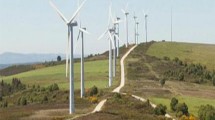Abstract
The main objective of the study here presented consists in developing a mathematical forecasting model of the available wind power output for an eight-hour horizon in wind farms that may be affected by inclement meteorological environments where the surface of the wind turbine blades can suffer of ice accumulation. These events may depend on several factors as air temperature, relative humidity, barometric pressure or wind speed, among others. In this way a precise model depending on the referred variables will allow predicting with higher accuracy the available power at the plant when the referred events may occur. A model based in neural networks for the prediction of the available power output of an experimental wind farm has been developed and tested using real data. The proposed model outperforms other professional commercial models.
Access this chapter
Tax calculation will be finalised at checkout
Purchases are for personal use only
Preview
Unable to display preview. Download preview PDF.
Similar content being viewed by others
References
Gasch, R., Twele, J. (ed.): Wind Power Plants. Fundamentals, Design, Construction and Operation, 2nd edn. Springer-Verlag (2012)
de Sistiernes, F.: Quantifying the Combined impact of Wind and Solar Power Penetration in the Optimal Generation Mix and Thermal Power Plant Cycling. Young Energy economists and Engineers (2011)
Giebel, G., Brownsword, R., Kariniotakis, G., Denhard, M., Draxl, C.: The State-of-the-art in Short-Term prediction of Wind Power. In: Deliverable D-1.2 Anemos.plus project, 6th Framework Program (2011)
Foley, A., Leahy, P., Marvuglia, A., McKeogh, E.: Current methods and advances in forecasting of wind power generation. Renewable Energy 37, 1–8 (2012)
Magnusson, M., Wern L.: Wind energy predictions using CFD and HIRLAM forecast. In: Proceedings of the European wind energy conference EWEC2001. Copenhagen, Denmark (2001)
Langberg, L.: Short term prediction of power production from wind Farms. Journal of Wind Engineering and Industrial Aerodynamics 80, 207–220 (1999)
Langberg, L.: Short term prediction of local wind conditions. Journal of Wind Engineering and Industrial Aerodynamics 89(3/4), 235–245 (2001)
Pinson, P., Madsen, H.: Adaptive modeling and forecasting of offshore wind power fluctuation with Markov-switching autoregressive models. Journal of forecasting 31(4), 281–313 (2012)
Karki, R., Hu, P., Billinton, R.: A Simplified wind power generation model for reliability Evaluation. IEEE transaction on Energy conversion 21(2), 533–540 (2006)
Erdem, E., Shi, J.: ARIMA based approaches for forecasting the tuple of wind speed and direction. Applied Energy 88(4), 1405–1414 (2011)
Chen, P., Pedersen, T., Bak-Jensen, B., Chen, Z.: ARIMA-based time series model of stochastic wind power generation. IEEE transactions on power systems 25(2), 667–676 (2010)
Cassola, F., Burlando, M.: Wind Speed and wind energy forecast through Kalman filtering of Numerical Weather prediction model output. Applied Energy 99, 154–166 (2012)
Methaprayoon, K., Yingvivatanapong, C., Lee, W., Liao, J.: An Integration of ANN Wind Power Estimation Into Unit Commitment Considering the Forecasting Uncertainty. IEEE Transactions on Industry Applications 43(6), 1441–1448 (2007)
Pinson, P., Siebert, N., Kariniotakis, G.: Forecasting of regional wind generation by a dynamic fuzzy-neural networks based upscaling approach. In: European Wind Energy Conference and Exhibition, EWEC 2003 (2003)
Fugon, L. Juban, J.; Kariniotakis, G.: Data Mining for wind power forecasting. In: European Wind Energy confenernce and Exhibition, EWEC 2008 (2008)
Kusiak, A., Li, W.: Short-term prediction of wind power with a clustering approach. Renewable Energy 35, 2362–2369 (2010)
Rahmani, R., Yusof, R., Seyedmahmoudian, M., Mekhilef, S.: Hybrid technique of ant colony and particle swarm optimization for short term wind energy forecasting. Journal of Wind Engineering and Industrial Aerodynamics. 123(part A), 163–170 (2013)
Homola, M.: Impacts and causes of icing on wind turbines. In: Interreg III project Wind Energy in the BSR: Impacts and Causes of Icing on Wind Turbines, European Union Project. Narvik University College (2005)
Febrel, A.: Estudio de Prestación de Servicios Complementarios con parques Eólicos. Bachelor Thesis (Industrial Engineering), Comillas Pontifical University, Madrid (2006)
Borggrefe, F., Neuhoff, K.: Balancing and Intraday Market Design: Options for Wind Integration. Climate Policy Initiative working paper (2011)
Tammeling, B., Cavaliere, M., Holttinen, H., Morgan, G., Seifer, H., Säntti, K.: Publishable report. Wind Energy production in cold Climate. Framework of the Non-Nuclear Energy programme (1998)
Jang, R., Sung, C., Mizutani, E.: Neuro-Fuzzy and Soft Computing: A computational Approach to Learning and Machine Intelligence. Prentice Hall (1997)
Jolliffe, I.T.: Principal Component Analysis 2nd edn. Springer Series in Statistics (2002)
Zugno, M., Jónsson, T., Pinson, P.: Trading wind energy on the basis of probabilistic forecasts both of wind generation and of market quantities. Wind Energy 16(6), 909–926 (2013)
Author information
Authors and Affiliations
Corresponding author
Editor information
Editors and Affiliations
Rights and permissions
Copyright information
© 2015 Springer International Publishing Switzerland
About this paper
Cite this paper
del Saz-Orozco, P., de Cañete, J.F., Alba, R. (2015). Development of a Power Output Forecasting Tool for Wind Farms Based in Principal Components and Artificial Neural Networks. In: Rojas, I., Joya, G., Catala, A. (eds) Advances in Computational Intelligence. IWANN 2015. Lecture Notes in Computer Science(), vol 9094. Springer, Cham. https://doi.org/10.1007/978-3-319-19258-1_30
Download citation
DOI: https://doi.org/10.1007/978-3-319-19258-1_30
Published:
Publisher Name: Springer, Cham
Print ISBN: 978-3-319-19257-4
Online ISBN: 978-3-319-19258-1
eBook Packages: Computer ScienceComputer Science (R0)




